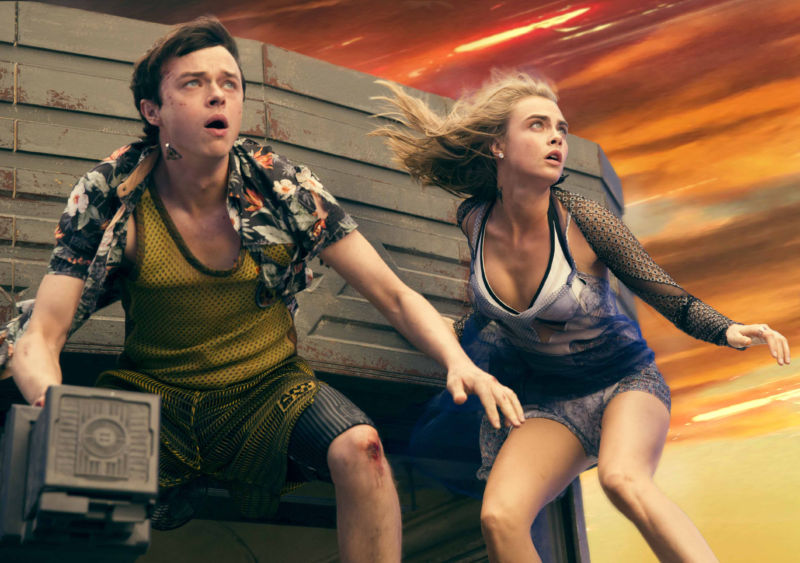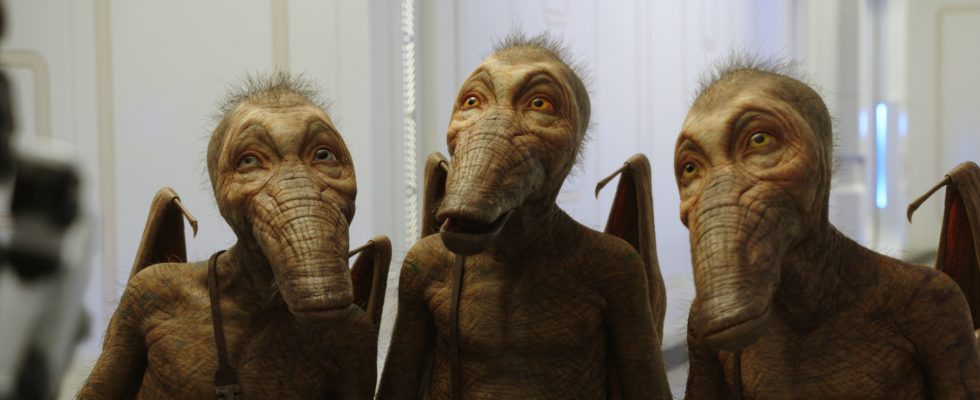
Valerian and the City of a Thousand Planets could be the most enjoyable 2017 film destined to win a Razzie award. Some of its disparate elements deserve a "bad," "poor," or even "embarrassing" rating. The film strays so far from its comic source material that you might call it treasonous. And it co-stars Rihanna, which, let's face it, has yet to work out well for a Hollywood production.
Even with those issues, I still had a blast. I went into my Valerian screening hoping to get "Luc Besson sci-fi," with elaborate, beautifully illustrated sequences, tongue-in-cheek schlock, and a weirdly French skew on high-octane cinema. Those expectations were met. I laughed, cheered, and roared both at and with the film. Valerian comes packed with just enough Fifth Element flavor to make it worth a solid, low-expectations trip to the movie theater.
Multipass?
-
Valerian gets ready to ride.
-
Laureline has had it with the massive space-dog trying to eat her bus.
-
A once-idyllic planet is destroyed, and its race of smooth-bodied aliens tries to survive.
-
One of many alien species introduced in the film's opening sequence. We never see most of them again.
-
"Which button is the 'make our romance believable' button?"
-
Once Valerian puts on an intergalactic headset, he finds his way to Big Market, which hosts the film's most impressive special-effects sequence.
-
The massive intergalactic space station known as "Alpha."
The franchise began life 50 years ago as a French comic series called Valerian and Laureline, which sent its titular characters across time and space to face, and overcome, a wild adventurous romp in each issue. Though the comic (which ended its original run in 2010) consistently served up gorgeous, otherworldly environs, they were often crowded out by verbose, text-packed speech bubbles that over-explained each planet-of-the-book storyline.
Besson opted to throw out much of that source material. The comic's verbosity is gone, as is the gimmick of our adventurers traveling through time. What we do get is the comic's archetypal setup of a bumbling-yet-successful male hero backed up by a much smarter and more resolute female space-trotting peer. In the film, the titular duo works for the military in a massive space station of thousands of races and species from across the universe. This harmonious colony in the stars is threatened, and Valerian and Laureline are tasked with rooting out and destroying a mysterious, energy-consuming virus.
In good news for filmgoers, the series' legacy of gorgeous sci-fi world design has been preserved—which makes sense, given that Valerian comic co-creator and artist Jean-Claude Mézières served as a concept artist for Besson's own Fifth Element in the '90s. The opening sequence alone looks like the dream sequence of a Henson Creature Shop staffer, in which humans greet and make diplomatic bonds with over a dozen gorgeously animated and rendered alien species—and then we never see those races again.
Besson earns this ballsy move by following the opening with many other memorable scenes, at least from an art-direction perspective. The film's plot draws in the rarest species of alien in the universe, whom we meet on their own idyllic, beaches-everywhere planet. A small population of svelte, glowing nymph-people hang out with a bunch of cute lizard-dragon-cat companions—who poop luminescent pearls everywhere as part of an annual ritual—but they soon face a planet-destroying catastrophe.
Laureline and Valerian eventually cross paths with the space nymphs in their first adventure, which starts in an apparently abandoned desert outpost. This is an alternate-dimension trading post, turns out, and donning a proper headset lets you walk, talk, and barter in a far more dense and populated city. Imagine the open air-highways of The Fifth Element, with so much verticality, then add incredible density of buildings and hologram signs, and you have Valerian's "virtual" outpost.
The outpost winds up hosting a sensational steal-and-escape sequence, with Valerian running through both dimensions (imagine the world's largest VR arcade floor, where pain and death in one world affects the other) while begging for help from Laureline and his other home-dimension allies. You have seen this type of heist play out in pulp-adventure and space-cowboy films before, but Besson's entry stands out with back-and-forth dimensional play and sensational green-screen set design.
Valerian's most memorable scenes essentially riff off of other space-opera archetypes, but usually to good effect. The film's primary spaceship-chase sequence uses its massive, species-rich space station as a colorful, visually diverse backdrop, and this lends the sci-fi cliché serious freshness. Likewise, an underwater submarine expedition and a one-against-all melee against a zillion aliens each benefits from what might be best described as a drunken auteur's touch, where dialogue and action each land in lighthearted, comedic ways.
What do you expect from someone named Jolly the Pimp?

But if you're looking to enjoy all of this stuff, you'll have to settle on some undercooked performances, which are at their best when the actors are in on the joke. Ethan Hawke and Eric Lampaert clearly got the Besson-cheesiness memo, with their over-the-top, hilariously weird turns as a pimp and a tour guide, respectively. (You can almost see them pantomiming Chris Tucker's unforgettable Fifth Element performance, but with their own unique spins.)
Rihanna's latest co-starring turn, meanwhile, is a hard one to love. She portrays a desperate, insecure super-prostitute who can read minds and change her outer appearance to tap into anyone's fantasies, and her brief turn in the film, with hilariously wooden dialogue saved only by a bunch of solid CGI effects, ends tragically. Even on her way out, after fighting for her own personality and redemption, her last statement to Valerian basically asks him: "was I good to you?" This moment might be one of the biggest Bechdel test flunks I've ever seen.
The hardest part about enjoying the film is Valerian himself, played by Dane DeHaan (The Amazing Spider-Man 2's Green Goblin). There's just no believing this guy as the tough, sexy, always-gets-his-way super-soldier that he keeps describing himself as; his talk is all Han Solo, but his walk is all Episode IV Luke Skywalker. Perhaps an older, cocksure-yet-stupid actor could have walked this line to more adventurous and comedic effect; I mean, even Fifth Element's Bruce Willis performance would've slotted in better than what DeHaan turned in.
Thankfully, actor Cara Delevingne has so much fun and kicks so much ass as Laureline that she lifts the duo almost singlehandedly. She's the quizzical, take-no-BS straight woman to the film's weirdest characters, and she really knocks that stuff out of the park with a humorous, likeable touch, especially with the comic's furry, snout-sporting "shingouz" creatures.
Unfortunately, Delevingne is handcuffed to an unconvincing plot device: that she has fallen for Valerian's tough-guy schtick. Besson threw out so much of the comic's source material that he should have done the same with the love and affection parts and let Laureline transcend her ultimately submissive love-interest role. This means you'll hear groan-worthy, unfunny "flirting" between these two all film, which is bad enough, but worse is the film's climax. The final scene hinges on a faith-and-trust argument between the young leads, and it's one reason the melodramatic, scream-filled ending had a few critics roaring in "wow, this is bad" laughter. (Clive Owen figures prominently in the ending, and there's a reason I haven't mentioned his turn in the film: If you don't have anything nice to say...)
If nothing else, Valerian plays out like Besson's thank-you gift to the original comic series, which he (and many other sci-fi authors and filmmakers) have paid uncredited homage to for decades. In spite of its obvious rough patches, the film is hokey and fun, and it runs at an enjoyably screaming pace (at least, until the boring climax starts to fall into place, which could have been cut down a good 10 minutes with nothing lost). His trippy, uncompromised vision takes enough chances to make this uneven film stand out above other ho-hum sci-fi, and I'll take ambition and giant failures in my popcorn fare over paint-by-numbers action films any day of the week.
reader comments
117